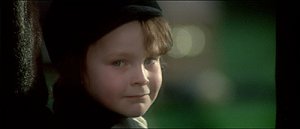The Omen
Thursday, October 8th, 2009 • Horrorthon Posts / Horrorthon Reviews
In 2006, when the remake of The Omen was released on June 6th (and titled The Omen 666, just in case anybody missed the point), the reviews argued that there was no reason to remake the “classic” Omen beyond the 6/6/6 date gimmick; the consensus seemed to be that the original was a renowned, well-regarded example of ‘Seventies horror (like The Exorcist, Halloween, The Texas Chainsaw Massacre and all the other landmarks from that decade that have served as bottomless wells of remakes and sequels) and that knocking off another 21st Century copy was the epitome of crass commercialism etc. I didn’t see The Omen 666 (for many reasons, not the least of which is my dislike of Liev Schrieber, a man whose career success baffles me), but I decided to give the first one another viewing for Horrorthon. Why not sample the original, well-regarded vintage of wine?
The thing is, I’m sorry, but it’s just awful. I know this is blasphemy, sacrilege etc. in horror movie circles, but I was actually kind of astounded at how bad a movie it is. There are some positive elements (and I’ll get to those below) but, for the most part, The Omen seems to bring together every weakness of ‘Seventies Hollywood filmmaking along with every lame element that gives the horror genre a bad name amongst mainstream moviegoers who don’t like it.
Maybe I’ve seen this particular kind of material (Biblical prophecies, evil children, curses) done well too many times to have any patience with the weak tea being served by Richard Donner (making his first blockbuster) and writer David Seltzer (whom IMDB reveals as having a fairly mediocre resume). And, I might be improperly respectful of the historical position this movie occupies as the first of its kind, etc. But I don’t think so, because it’s conspicuously not the first of its kind; even back then, I was vaguely aware of The Omen as the latest in a Hollywood trend that includes Rosemary’s Baby and The Exorcist, which are vastly superior films made by supremely talented directors and writers. (William Friedkin had won Best Director for The French Connection, the 1971 Best Picture Oscar winner, and Roman Polanski…well, let’s quickly change the subject.) So I can’t even give The Omen credit for “inventing” anything (except for the really scary teaser poster campaign, which freaked me out in Manhattan subway stations for months before I even found out what the posters were advertising).
So what’s wrong with The Omen? First (or, at least, most conspicuously), there’s the major problem of Gregory Peck. Yes, he’s Atticus Finch, and yes, he’s very good looking in a stolid, Jimmy-Stewart-crossed-with-George-Clooney way, but he’s just a miserable, miserable actor. He’s one of the last of that breed of antique non-actor matinee idols (along with John Wayne and Cary Grant) to stagger forward into the ’Sixties and ’Seventies. past the revolutions in method acting and naturalism and the French New Wave, bringing their broad, anachronistic theatrical styles with them. The equivalent phenomenon today (‘Seventies icons like Al Pacino and Christopher Walken appearing in modern movies) is vastly more flattering to the veteran performers; nobody from 1940s movies was going to come across well in the decade of Sidney Lumet and Martin Scorsese. But it’s worse than that, because Peck was just always bad; he ruins Hitchcock’s Spellbound and he ruins John Huston’s Moby Dick, and he’s not even a good Atticus Finch, when you really scrutinize the performance. He’s like a guy with the flu—he can’t talk or emote because his sinuses hurt; he just wants to go lie down.
Then there’s Damien, the Antichrist. In any ranking of frightening threats, “The Antichrist” would obviously be close to the top of the list; this is somebody you want to regard warily, to say the least. It’s such a scary concept, in fact, that it propels the viewer through two hours of exquisite mounting fear in the vastly superior Rosemary’s Baby without the titular baby even once appearing onscreen. But this time, the apocalyptic child is directly in front of us in many, many tight close-ups, which is why he’s such a letdown. Damien doesn’t do anything, ever, throughout the film (except have a badly-dubbed and chaotically-photographed hissy-fit inside a limousine, which comes across more as “bratty kid” than “Spawn of Satan”). As in Rosemary’s Baby, the danger comes from elsewhere; from the shadowy figures in Europe and America who are charged with protecting the Antichrist, so that he can grow to manhood undisturbed. This is a great concept, but in this movie it translates into a bunch of Italian monks chewing the scenery and a smirking, glowering nanny in black clothes whom any reasonably alert person would have fired the same day. (Rather than by a reasonably alert person, the household is run by Lee Remick as another in the thankfully-obsolete series of moron Hollywood housewives photographed through diffusion filters).
I mentioned The Omen’s saving graces, above, and there are a couple. David Warner (as a photographer picking up Kirlian emanations in his pictures, and going bananas trying to figure them out…in the end, he’s sorry he asked) brings some much-needed energy to the movie, and his scenes are pretty good; through those sequences (mercifully distant from the inert kid and the nanny’s Disney-level mugging) we get an interesting window into the Satanic rituals and inverted Biblical rhetoric that would surround a modern fulfillment of a millennia-old prophecy. Jerry Goldsmith’s Oscar-winning score isn’t bad, and Donner provides some evidence (some meager evidence) of the snappy visual skills he would bring to bear later, starting with his very next picture (Superman). And the business with the nanny hanging herself is legitimately shocking and effective. But in general, The Omen is a big dud. When people who don’t know any better complain about the tackiness of the ‘Seventies, they’re talking about stuff like this.


